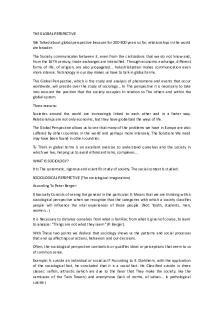Chapter 2 The Biological Perspective PDF

| Title | Chapter 2 The Biological Perspective |
|---|---|
| Author | Cayla Hines |
| Course | General Psychology |
| Institution | North Carolina A&T State University |
| Pages | 3 |
| File Size | 136.2 KB |
| File Type | |
| Total Downloads | 48 |
| Total Views | 161 |
Summary
For Professor Jones's General Psych...
Description
Chapter 2: The Biological Perspective ● The Nervous System is an extensive network of specialized cells that carry information to and from all parts of the body. ● Neuroscience deals with the structure and function of neurons, nerves, and nervous tissue ○ Relationship to behavior and learning ● Parts of a Neuron Glial Cells ● Provide support for neurons to grow ● Deliver nutrients to neurons ● Produce myelin to coat axons Myelin ● Fatty substances that coat axons and insulate and protect neurons as well as speed up neural impulse ● Clean up waste products and dead neurons Ions ● Negatively charged when inside but positively charged when outside of neuron ● Resting potential: state of neuron when nothing is happening ● Action Potential: Release of neural impulse which reverses the negative charge in axon which allows positive sodium ions to enter the cell ● All-or-none: Neuron either fires or it doesn’t ● The Neural Impulse Action Potential ○ NEUROTRANSMISSION ● Synapse/Synaptic Gap ○ Microscopic fluid-filled space between the rounded areas on the end of the axon terminals of one cell and the dendrites or surface of the next cell ● Receptor Sites ○ Holes in the surface of dendrites or certain cells of the muscles and glands, which are shaped to fit only certain neurotransmitters ● Neurons must be turned on and off ○ Excitatory neurotransmitter: “fire”; Neurotransmitter that causes the receiving cell to fire ○ Inhibitory neurotransmitter: stop; Neurotransmitter that causes the receiving cell to stop firing ● Agonists: Mimic or enhance effects ● Antagonists: Block or reduce reactions Cleaning up the Synapse ● Reuptake: Process by which neurotransmitters are taken back into the synaptic vesicles ● Enzymes: Complex protein that is manufactured by cells
The Central Nervous System is the part of the nervous system consisting of the brain and spinal cord ● Brain: core of the nervous system ● Spinal cord: a long bundle of neurons that carries messages to and from the body to the brain that is responsible for very fast, life saving reflexe ● Sensory neuron: a neuron that carries information from the senses to the central nervous system ○ Also called an afferent neuron ● Motor neuron: a neuron that carries messages from the central nervous system to muscles of body ○ Also called an efferent neurons. ● Interneuron: a neuron found in the center of the spinal cord that receives information from the sensory neurons and sends commands to the muscles through the motor neurons ○ Interneurons also make up the bulk of neurons in brain ● Damage once thought to be permanent ○ Neuroplasticity: ability to constantly change both the structure and function of cells in response to experience or trauma ○ Neurogenesis: formation of new neurons...
Similar Free PDFs

Chapter 4 The Trait Perspective
- 20 Pages

The Altered Perspective
- 6 Pages

THE Global Perspective
- 38 Pages

The behavioral perspective
- 2 Pages

COMM1011 CH.2 Perspective
- 6 Pages
Popular Institutions
- Tinajero National High School - Annex
- Politeknik Caltex Riau
- Yokohama City University
- SGT University
- University of Al-Qadisiyah
- Divine Word College of Vigan
- Techniek College Rotterdam
- Universidade de Santiago
- Universiti Teknologi MARA Cawangan Johor Kampus Pasir Gudang
- Poltekkes Kemenkes Yogyakarta
- Baguio City National High School
- Colegio san marcos
- preparatoria uno
- Centro de Bachillerato Tecnológico Industrial y de Servicios No. 107
- Dalian Maritime University
- Quang Trung Secondary School
- Colegio Tecnológico en Informática
- Corporación Regional de Educación Superior
- Grupo CEDVA
- Dar Al Uloom University
- Centro de Estudios Preuniversitarios de la Universidad Nacional de Ingeniería
- 上智大学
- Aakash International School, Nuna Majara
- San Felipe Neri Catholic School
- Kang Chiao International School - New Taipei City
- Misamis Occidental National High School
- Institución Educativa Escuela Normal Juan Ladrilleros
- Kolehiyo ng Pantukan
- Batanes State College
- Instituto Continental
- Sekolah Menengah Kejuruan Kesehatan Kaltara (Tarakan)
- Colegio de La Inmaculada Concepcion - Cebu










